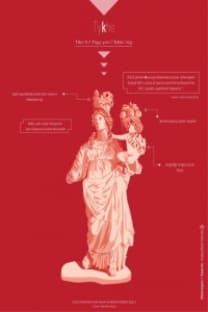Tykhe ya da Fortuna
Yunan dünyasının, Olympos'lu olmamasına rağmen, bir Olympos'lu kadar saygı gören tanrıçasıdır Tykhe. Şans, talih, beklenmeyen ya da umulmayan başarıların tanrıçasıdır. Pausanias, Pindaros gibi antik yazarlar tarafından da övgüyle söz edilen çok sayıdaki tasviri, hem Yunan hem de Roma İmparatorluğu'nun geniş coğrafyasında ne kadar saygı gören bir tanrıça olduğunu ortaya koyar. Tanrıça Tykheya da Roma'daki adıyla Fortuna, insanlara iyi şans ve talih getirmesinin yanında, kötü şans veya kötü olaylar da getiren bir tanrıçadır. Tykhe genellikle başında, bir kentin koruyucusu olduğunu gösteren kule şeklindeki tacı ve elinde bereketin ve bolluğun sembolü olan bereket boynuzu cornucopia ile tasvir edilmiştir. Bunun yanında, özellikle Roma'nın doğu eyaletlerinde Antiokheia, Ceasarea, Berytus, Mısır ve Küçük Asya'da bir gemi pruvası ile ya da elinde tuttuğu bir dümen ile olan tasvirlerinde, deniz ya da nehir taşımacılığını ve ekonomisini simgelemiştir. Farklı coğrafyalarda, o kültüre özgü tanrılar ile birlikte ortak tapım görmüş olan tanrıça adına yapılmış az sayıda tapınak vardır. Tanrıça ile ilgili en önemli görsellere kent sikkeleri üzerinde rastlanır. Anadolu sınırlarında, tanrıçanın en sağlam heykellerinden biri bugünkü Düzce İli, Konuralp Mahallesi sınırlarındaki Prusias ad Hypium antik kentinde, 1931 yılında bulunmuştur. Bu heykel, bölgedeki tarımsal ekonominin ve ticaretin önemini vurgulamak için başında bitkisel bezemeli yüksek bir taç, sağ elinde bir dümen ve sol kolunda, içi olasılıkla bölgeye özgü meyveler ile dolu bir bereket boynuzu ile sağlığın simgesi bebek tanrı Pluto'yu Asklepios tutar biçimde betimlenmiştir. İ.S. 2. yüzyıla tarihli bu eser bugün İstanbul Arkeoloji Müzesi'ndedir
TYCHE OR FORTUNA
Tyche is a Greek goddess that is respected as much as Olympians, although she is not an Olympian. She is the goddess of chance, fate and unexpected success. Many images and statues, which are mentioned by ancient writers such as Pausanias and Pindar with praise, reveal that how an important figure in the vast geographical area of Greek and Roman social world. The Goddess Tyche in Greece or Fortuna in Rome is also famous for bringing bad chance or events for people as well as good fortune. The goddess has generally been portrayed with her attributes such as mural crown which symbolize of her patronage of the cities, cornucopia which represent the fertility and abundance. Her descriptions with rudder or prow, which are seen in especially Roman eastern provinces Antioch, Caesarea, Berytus, Egypt and Asia Minor, are associated with the importance of maritime trade or river transportation. She had a small number of Temple, because she generally had to share her divinity with other deities. The most of her images are frequently depicted on the city coins. One of the most preserved statue of Tyche was come to light within the boundaries of Prusias ad Hypium ancient city in modern Konuralp or Üskübü in 1931. This statue, which is represented with a high crown with floral decoration, cornucopia that full of with many region-specific fruits, child god Pluto wealth , and a rudder that is held by Goddes' right hand, emphasize the agricultural important of the city. This statue is dated to 2nd century AD and now, it is exhibited in İstanbul Archaeology Museum
___
- Arya, D.A. The Goddess Fortuna in Imperial Roma: Cult, Art, Text, 2002, (Doktora Tezi)
- Erhat, A. Mitoloji Sözlüğü, İstanbul 1997
- Hesiodos, İşler ve Günler/Tanrıların Doğuşu, Çev. Furkan Akderin, 2012
- Necatigil, B. 100 Soruda Mitologya, 2003
- Scranton, R. L. Corinth, I, iii,Monuments in the Lower Agora and North of the Archaic Temple, Princeton 1951
- Zeyrek, T. -G. B. Çelik, Prusias ad Hypium. Anadolu'nun Kuzeybatısında Antik Bir Kent, İstanbul 2005
- https://commons.wikimedia.org/wiki/File:Tyche_Pluto_Prusias_ad_Hypium_IstA rchMu451b.jpg
- http://www.pbase.com/image/60375036
- Plinius, Naturalis Historia, http://data.perseus.org/catalog/urn:cts:latinLit:phi0978.
- http://www.tycheofantioch.com
- Resim 3. AntiokheiaTykhe'si. (http://www.tycheofantioch.com/)
- Resim 5. (A ve B) Tanrıça Tykhe ve çocuk tanrı Pluto. Prusias ad Hypium. İ.S. 2. yüzyıl. İstanbul Arkeoloji Müzesi (https://commons.wikimedia.org/wiki/File:Tyche_Pluto_Prusias_ad_Hypium_IstA rchMu451b.jpg; http://www.pbase.com/image/60375036)
